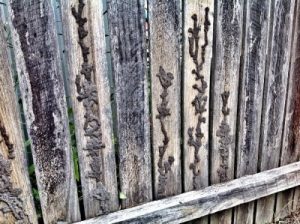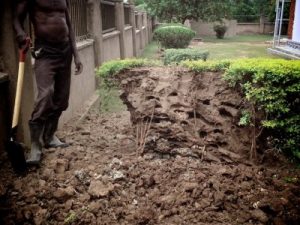
Termites feed on dead wood, especially the one inserted into the ground. Your neighbors might say it’s okay and you shouldn’t bother with termites infesing your fence.
In fact, sometimes termites may live in a fence for years and not encounter your house. However, they will slightly weaken your fence untill it gets completely destroyed.
And since there is definately going to be a termite colony established nearby, these insects will lurk for other food sources in 100 meter radius. That means, your house and other wooden structures (including trees) will be potentially at risk.
Hide content
- Signs of termite infestation
- How to deal with termites?
- Useful articles
- Helpful video
- Yearly inspection
Of course, your neighbors might say they’ve never seen termites stretching structures on the ground, but will you care of that “statistics” when one of your trees suddenly falls on your neighbor’s property and you will be sued? Down below you ll find out how to prevent such a case and deal with termites in your fence.Signs of termite infestation
You might have noticed tiny thin canals on your fence – the obvious sign of termite presence.
There may also be tiny holes, sometimes with wood dust nearby. When termite flying “scouts” reach the destination, they drop off their wings you can notice aswell.
If you are “lucky”, you might have spotted one of these disgusting insects – if so, then there is from 250,000 to 1 million of termites in nearby nest. And the queen produces 3000 eggs a day.
Also, if you have somehow noticed termites in your house/trees or any other piece of wood on your yard, the termites operating there might be from the nest inside of your fence or just somewhere around.
To test the fence, try to penetrate it with a screwdriver or something like that – if the wood feels soft or moist, termites were unlikely to miss such a food source (tip: termites DO LIKE moist, so any wet piece of wood is an invitation for them).
Even if you didnt find any signs of termite presence yourself, they are most likely present somewhere in your garden, if you dont have a chemical barrier.
That’s why it is recommended to make a pest inspection each year (be sure to consult termite accredited pest control companies or independent workers with about 5 years of experience and good recommendations – these tend to do the job with higher responsibility, than medium/large companies).
TIP: Pest control company report is often a condition for sale of the house.Learn more about drywood termites: signs of their activity; best methods of treatment: spot treatment and DIY methods; how to get rid of them in furniture?
And also about subterranean termites: signs of their activity; best methods of treatment and DIY methods. Eastern subterranean termites and their tunnels and tubes with photo.How to deal with termites?
You see, removing the old infested fence might be an option (especially if it is heavily damaged, though be sure to burn all the pieces), but doing so wont stop termite activity – they’ll just start looking for another food source. Thus, you have to deal with standard termite control measures anyway.
To ensure the safety of your house, make sure the soil does not contact with the wooden parts of the building (it should be several inches above the ground).
Also, make sure no pieces of wood contact with the building’s wood (be it tree branches or just a leaning broom) as all of these may act as bridges for the termites to invade your house.
The most environmental-friendly way of killing termites is by using termite bait traps. If you are dealing with termites right near your food plants, you really dont want them to absorb pesticides.
Now, bait traps are installed into the ground with 1 trap for every 3 meter around the fence perimeter and about 30 cm away from the structure.
Here you can learn more information about effective termite control remedies: Bora-Care, Boric acid, Borate, Fipronil, Chlorpyrifos, Chlordane, Borax, Timbor, Termidor, Terminator, Phantom, Lorsban, Biflex, Terro. You can choose different forms, such as – foam, liquid, powder.
Dead wood pieces are inserted inside to act as a bait. You need to check them every 2 months for termite activity, to see if they discovered your bait. If so, you just put a poisoned bait inside the trap and refill it if necessary.There are differents kinds of baits. Contact poison bait kills termites quickly, but that will be around 1000 of insects dead a day or so – considering their quanitities and reproduction rate it is not going to be any effective.
This way you will need a growth hormone bait, which quickly kills new generations of termites(that way the population will die out once all the elder termite workers are gone).
The problem with termite bait traps is that termites can just bypass them completely and it takes a lot of time to kill the population(it may take 6 months or even more). They are also relatively expensive.
The most effective way to protect your yard (including fence) from termite activity is chemical barrier. This is done by liquid termiticide soil treatment. There are repellent and non-repellent termiticides on the market.
Repellent ones are chemicals designed to repell all the termites passing by, but it is vunerables to breaches in the barrier and wont kill the termite colonies inside of your yard. The non-repellent termiticides are slow acting poisons, which often kill termites stealthy and have a transfer effect.
Due to transfer effect the poison is being spreaded by termites contacted it throughout the whole colony, so the whole termite nest gets eliminated along with all of the workers with time. The most effective liquid termiticides here are fipronil-based (e.g. Termidor).
Chemical barrier is considered safe to people and mammals if applied properly, modern chemicals do not contaminate the soil long-term and decay within 5 years, however they can still be accumulated in food plants and water bodies, so this should be taken into consieratio, if you applying them.
If the ecology is an issue, search for the “green” (environmental-friendly) non-repellent termiticides on the market.
Also, chemical barrier kill termites about 2-6 times quicker than bait stations (it is about 3 months for Termidor to eliminate the colony). If there is an opportunity, it is alwayts recommended to apply this type of termite control for it’s effectivity.
Here you can learn more information about termite bait systems: Advance, Green, CSIRO, Nemesis, Exterra, Firstline, Terminate. Also find out how to make baits by yourself and how to refill them?
If you are planning to replace your infested fence, consider non-wood materials, or CCA-treated timber. CCA-treated timber is a wood treate with Copper Chrome Arsenate. Copper and arsenic protect wood from insects and fungi, and chrome just keeps the chemicals together.This mixture is injested into the timber under the pressure, so the wood gets saturate with it. This treatments also prevents normal wood decay. Such timbers are often used in building communications and infrastructure objects, public gardens, children’s playgrounds, so it’s a common and safe technology. This kind of wood has a slight green color which fades with time.
Useful articles
If you interested in more information of termites we recommend you to read the following articles:
- All types of termites. Are they harmful to humans? Can they bite you? And what is the difference between drywood and subterranean ones?
- What does swarmers of different species look like: drywood, subterranean, formosan?
- Signs of infestation outside and in the house: in walls or furniture.
- How to treat them at home and in the yard: in wood. How long this process lasts and what is pre-construction and soil treatment?
- What does termite holes look like? What is droppings and is it toxic to humans? Do termites make noises?
- Posible termite damage, how does it look like? Examples of damage in walls and wood floors.
- All about flying termites: how do they look like, swarming season and what to do if there are swarmers in your house?
- How do they do nests and mounds? How to find it in your garden or inside the house?
- Termite life cycle – from egg to larvae. And social hierarchy: workers, soldiers, queen.
- Did you know that termites can infest living trees, for example a palm or a pine tree. They also like to live in stumps.
- You can prevent the infestation by using barriers, such as: HomeGuard, Physical systems, Safeguard, Stainless steel mesh, Kordon.
- If you want to get rid of termites naturally, learn more about such methods as: heat or cold treatment, orange oil, using nematodes.
Helpful video
Fence with live termites:
Yearly inspection
Keep in mind that even if you applied all the measures necessary to kill the termites and rptect your fence from them, a pest company specialist should inspect your yard every year to make sure there is no possible termite threat.
And remember, statistically it is cheaper to spend 2000$ once every 5 years than to suddenly sustain a hughe uneconomic damage to your house and other structures, which will take your money, nerves and time to fix and break all of your plans.
Prevention is better than cure.
